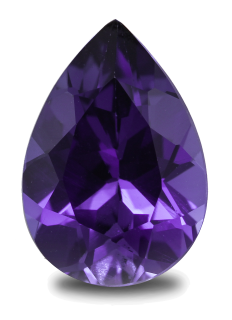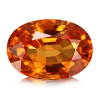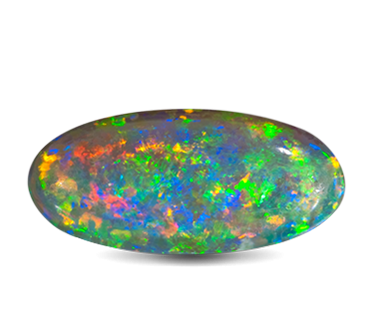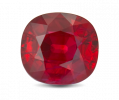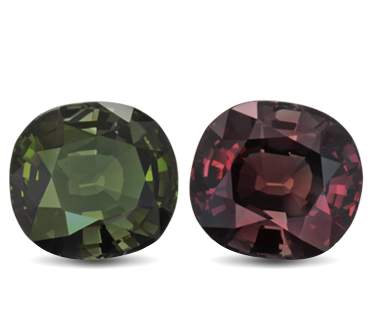
Alexandrite is a stone that belongs to the chrysoberyl family that transforms from green or blue-green to purple-red or purple when viewed under different light sources (daylight or incandescent lamp). This type of chrysoberyl was first discovered in the Urals in the 1830s, and named alexandrite in honor of the future Tsar Alexander II of Russia by Nils Adolf Erik Nordenskiöld (November 18, 1832 - August 12, 1901) in 1842.
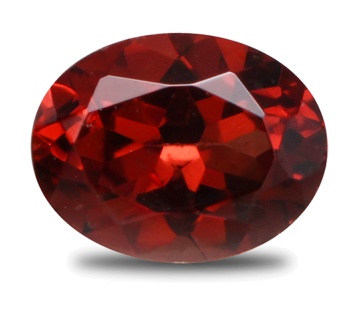
Almandine is the ferrous iron end member of the class of garnet minerals from the isomorphous subgroup of piralspit group of garnets, colored in red with light orange, brownish or purple hues or without them. The name is a corruption of Alabanda area (now the Aydin province in Turkey), a region in Asia Minor, where this mineral and other "carbuncles" predominantly entered the markets of ancient Europe from (according to Pliny the Elder). The name of the mineral was introduced into use in 1546 by Georgius Agricola, the real name is Georg Bauer, years of life 1494-1555, in the work "Bermannus sive de re Metallica" (On Mining and Metallurgy).
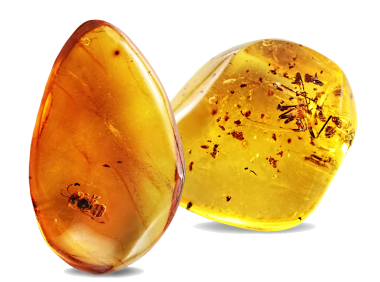
Amber is the name of a lithified organogenic formation - a fossil resin of the superfamily (“department”, according to O. Martirosyan) of amber-like resins. Takde traditionally refers to amber fossil resins that do not contain succinic acid, but structurally close to amber, possessing similar technological properties.
The Russian name "amber" comes from the Lithuanian name of the stone - "gintaras".
Varieties of amber used in the manufacture of jewelry and jewelry, refer to the jewelry and gemstones. The source of the formation of amber was the resinous discharge of conifers of the Araucaria, Pine and Cypress families.
Amber, like other fossil resins, is currently classified as a mineraloid from the point of view of mineral matter, but still there are publications in which amber belongs to minerals of organogenic origin.
A clear separation of amber and fossil resins, which are not amber, is possible only according to infrared spectrometry data.
At present, amber is attributed to: succinite, gedano-succinite, rumenite, burmit, shraufit, simetit, bekkerit, stantinit, as well as resins close to them — cheavinit, tsedarit, and others.
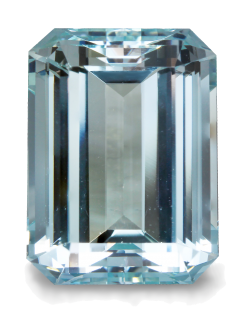
Aquamarine is a variety of the mineral beryl, colored in a blue-green color with all the variety of tonal hues. This variety of beryl is separated from topaz by Anselm Boethius de Boot of Bruges (circa 1550 - 21.06.1632) in the work "Gemmarum et lapidum historia", published in 1609. The name "aquamarine" is derived from two Latin words: aqua, meaning "water" and marina, meaning "of the sea" and goes back to the definition of blue transparent stones given by Pliny the Elder.
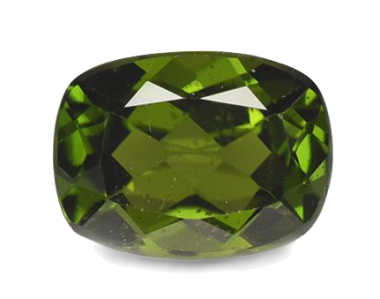
Chrome-diopside is colored with a basic green color with an admixture of shades of yellow or blue, depending on additional chromophore impurities. Coloring, as a rule, has a high degree of saturation. The chromophore content of chromium on average is about 0.5%, but in some cases it can reach up to 2% (in terms of Cr2O3).
In the 1990s, chrome-diopside was advertised under the trade name "Yakut emerald", but since this term can be misleading with respect to the mineral species, this brand was found to be incorrect and not recommended for use. However, you can still hear this beautiful and romantic name - "Yakut emerald", which has no relation to either emerald or beryl.
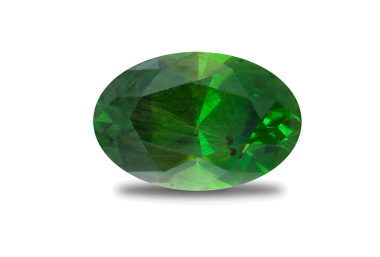
Demantoid is the gemstone variety of the mineral andradite garnet, colored in various hues of green color with or without brown or yellow shades. The name of the mineral comes from the German (official language of the mining and geological industry in the 19th century) "diamante" - diamond and the ancient Greek "εἶδος" - a kind of appearance similar to the dispersion of light, like a diamond.
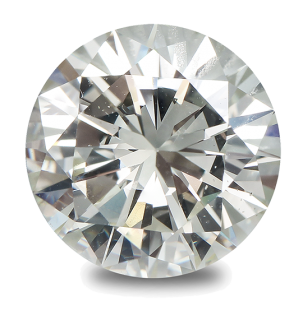
Diamond is a solid form of carbon with a diamond cubic crystal structure. The name of the mineral has been known in Russian since the 15th century that is derived from the Turkic and Iranian-speaking peoples (Turkish "elmas", Arabic "لماس", Persian "الماس"), where it came from the ancient Greek "ἀδάμας" - "indestructible, irresistible".
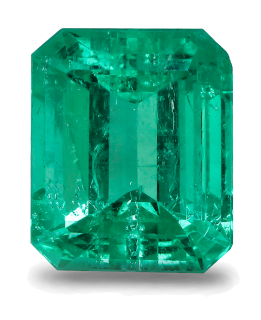
Emerald is a variety of the mineral beryl, colored green by trace amounts of chromium varying of a blue hue of color. The Russian name "emerald" is derived from the Turkish name of this stone "zümrüt", distorted during the times from the Semitic root "shine" (for example, the closest in sounding in Hebrew "בָּרֶקֶת" - "bareket" and in Sanskrit "मरकत" "Marakata" is an "emerald").

Lazurite is a mineral species, class of silicates, a subclass of tectosilicates (frame silicates), feldspatoidae family, sodalite groups. Its color is characterized by a basic blue color with hues ranging from violet to green.
The name "lazurite" comes from the Persian name of this stone - "دلاژر" (lajjvar). As a jewelery-ornamental stone, lapis lazuli has been known since antiquity, its products are found in the tombs of Egypt and Mesopotamia, mention of it can be found in Aristotle and Theophrastus.
A detailed description of it as “lapide-lazulli” is given in 1609 in his work “Gemmarum et lapidum historia” by Boethis de Boodt (Anselmus Boëtius de Boodt, 1550-1632).
The name “Lazurite” (lapis lazuli) jewelry stone was applied to the mineral as a mineral species in 1868 by James Dan (James Dwight Dana, 1813-1895) in the work “System of Mineralogy, 1868” (first edition in 1837 ). The term “lapis lazuli” was first used in an article by Waldemar Breugger (Waldemar Christofer Brøgger; 1851–1940) and Helge Beckström (Helge Mattias Bäckström, 1865–1932) “Die mineralien der Granatgruppe”, published in the Journal of Crystallography and Mineralogy (Zeitschristum, 17). Krystallographie und Mineralogie) in 1891.
Nowadays, the term “lapis lazuli” together with the term “lapis lazuli” is often used in trade practice for the name of a lapis lazuli-containing rock, used as a jewelry-ornamental and ornamental stone.
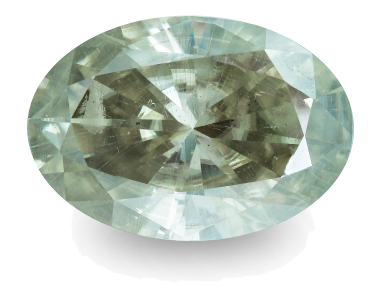
Moissanite is a natural mineral discovered by Henri Moissan (Ferdinand Frederic Henri Moissan, 1852-1907) in meteorite samples collected in the Devil Canyon meteorite crater (Canyon Diablo, Arizona, USA). Crystals of naturally occurring silicon carbide along with other minerals from meteorite material were discovered by Henri Moissant in 1904 in the periodical edition of the French Academy of Sciences (Comptes rendus hebdomadaires des séances de l'Académie des sciences). In 1905, on the initiative of George Frederick Kunz (George Frederick Kunz, 1856-1932), the mineral was given the name "moissanite" in honor of the discoverer of this natural mineral (artificially silicon carbide has been known since 1849) and in recognition of his achievements in studying natural carbides.
For the first time in rocks of terrestrial origin, moissanite was discovered in 1958 in low-temperature cubic polymorphic modification (β-SiC) in sandy shale deposits of the Green River Formation (Wyoming, USA). Later, in 1959, it was also found among the minerals of kimberlite rocks (Yakutia, USSR) in the form of a hexagonal polymorph (α-SiC).
The method of obtaining an artificial analogue of moissanite, called carborundum, was patented in 1893 by the American chemist Edward Acheson (Edward Goodrich Acheson, 1856-1931).
Natural moissanite is a dark (to black), almost opaque due to the large number of inclusions of grain and crystals. Thus, all inserts made of silicon carbide used in jewelry and called “moissanite” are in fact “carborundum” (in accordance with the Acheson patent), and in the case of using the term “moissanite” it is necessary to use the definition of synthetic.

Nephrite is a jeweler’s ornamental and ornamental stone, less commonly used as decorative collection geological material. Nephrite is a rock of metasomatic genesis of cryptocrystalline (hidden fibrous) structure. It has an essentially amphibole mineral composition (more than 85%), represented by tremolite – actinolite minerals. The mineral composition of jade often contains other minerals, which may account for up to 15%. Among such minerals, silicates (talc, serpentine, diopside, titanite, zoisite, epidote supergroup minerals, chlorite minerals, and others), carbonates (calcite, dolomite), oxides (magnetite, chromspinellides), and also graphite are distinguished.
Some researchers, on the basis of the generality of the mineral composition and physical properties, refer to the nephrites as a jewel-ornamental stone, dianite, which is not entirely correct, since the main rock-forming mineral of dianite is richterite.
The name jade (the Greek word “νεφρός” - “kidney”) was introduced into use by the French naturalist and mineralogist Alexis Damour (Augustin Alexis Damour; 1808-1902), who for the first time established that gemstone jewelery stones combined by the term “greedy” (“piedra”) de ijada ”), not homogeneous in mineral composition. He separated these rocks into jadeitites composed of pyroxene-jadeite and nephrites composed of amphiboles of a number of isomorphic tremolite-actinolite miscibility.
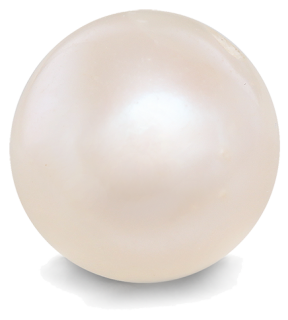
A pearl is a hard organogenic object produced within the soft tissue of mollusc shells. Although these may also be legitimately referred to as pearls by gemological labs - "elephant pearls", "bamboo pearls" and a number of others. The Russian name "pearl" comes from the Chinese name "zhen zhu" ("珍珠") through Turkic borrowing.
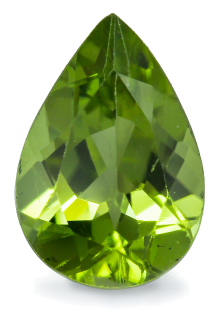
Peridot is gem-quality olivine colored in green color of different intensity, most often with a yellowish hue. Peridot is the fayalitic minal variety of olivine according to mineralogical classification with the "forsterite-fayalite" within the range of 10-30% (olivine itself in foreign literature). Peridot is the gem variety of the mineral olivine in English-speaking countries. This name was registered at the CIBJO congress in 1968. The name "peridot" comes from the ancient Greek - "χρυσός" - "gold" and "λίθος" - "stone" (golden stone).
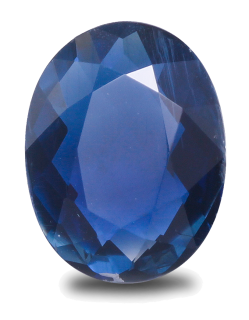
Sapphire is a gem-variety of the mineral corundum, colored in blue with light purple or green hues or without them in Russia. The Russian name comes from the ancient Greek "Σάπφειρος" - a stone of blue color. Blue sapphires are graded basing upon the purity of their primary hue – blue sapphire in world practice.
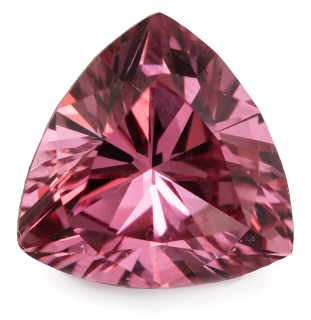
Spinel is the magnesium aluminium member of the large spinel group of minerals. Spinel occurs in an array of colors. Its wide and varied palette of colorless, black, red, yellow-orange, green, blue, and purple-purple.
For the first time the name "spinel" was used in the book "De natura fossilium" ("On the Nature of Minerals") by the German scientist Georgius Agricola (Georg Bauer, 1494-1555) in 1546. He singled out this mineral from a common series of "carbuncles" based on hardness and Lustera. And the name spinel came to be used in 1797 by Martin Klaproth (Martin Heinrich Klaproth, 1743-1817). There is no information on the origin of the name. Different researchers derive the name from different languages respectively, and with different meanings.
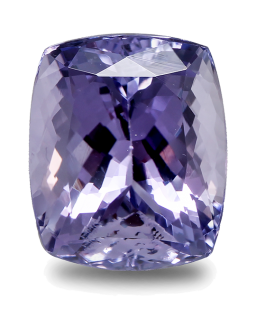
Tanzanite is a gem variety of the mineral zoisite, colored in purple and blue. The gemstone was given the name "tanzanite" by Tiffany & Co. after Tanzania, the country in which it was discovered. The scientific name of "blue-violet zoisite" was not thought to be consumer friendly enough by the marketing department, who introduced it to the market in 1968. Scientifically called "blue zoisite", the gemstone was renamed as tanzanite by Tiffany & Co., who thought that "blue zoisite" (which might be pronounced like "blue suicide") wouldn't sell well. The new commercial name turned out to be very successful and was confirmed for this chrome vanadium variety of zoisite as official, which nobody considered it necessary to challenge.

Topaz is a silicate mineral of aluminium and fluorine with the chemical formula that crystallizes in the orthorhombic system with additional anions (F- and OH-). The name "topaz" of the mineral is usually derived from the Green according to the ancient name of the island of Zabargad in the Red Sea - "Topaz" by Anselm Boethius de Boot of Brugge (circa 1550 - June 21, 1632) in the work "Gemmarum et lapidum historia", published in 1609, with reference on Pliny the Elder.
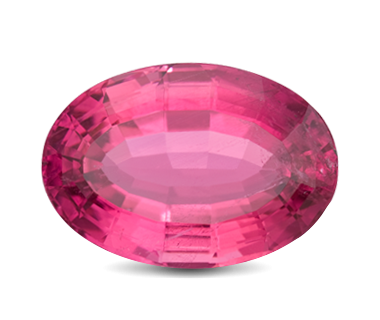
Tourmaline is a crystalline boron silicate mineral compounded with elements such as the silicon-oxygen tetrahedra in the structure of the crystal lattice. The origin of the name of the mineral has several interpretations. According to the Sinhalese the name "turamali" means "a stone of different colors". The name "Tourmaline" war recorded in the book "Curious speculations in sleepless nights" (Curiöse Speculationes bey Schlaflosen Nächten) by Johann Georg Schmidt published in 1707 in Europe. Tourmaline is mentioned as a stone brought back in 1703 by the Dutch from the island of Ceylon. There was a name "schorl" until the end of the XIX century in Russia. Commonly encountered two of three species and varieties that are used in the manufacture of jewelry inserts - a group of alkaline tourmalines and a group of calcium tourmalines. Alkaline tourmaline include such minerals as: schorl (and species), dravite (and species), tsilayzit, elbaite and others (without gemmological practice). Calcium tourmalines include such minerals as: scythed (and species), fluoride-liddicoatite and others (without gemmological practice).
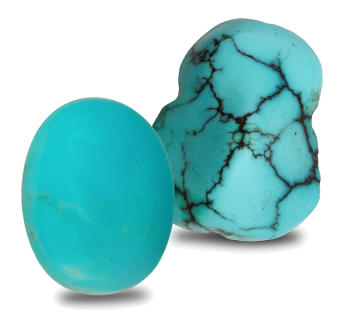
Turquoise is a mineral that is a hydrated phosphate of copper and aluminum with an additional hydroxyl ion. The Russian name of this stone - "turquoise" - is derived from the Persian names of this stone: "فیروزه" ("firuse") - the stone of happiness; "پیروز" ("piruz") - winning, giving victory due to the fact that turquoise in Russia was directly supplied from Persia.
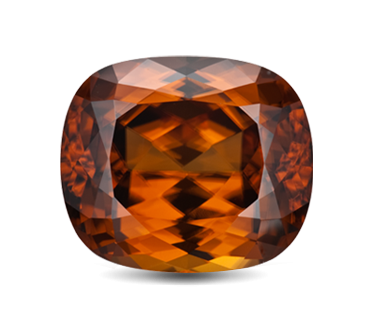
Zircon is a mineral which chemical name is zirconium silicate. It is possible that this particular mineral called "hyacinthus" is mentioned in the "Natural History of Fossil Tel" by Guy Pliny the Elder. However, V.Severgin expresses doubts that this term was understood to be zircon, but not another mineral (Severgin points to cordierite) or a group of minerals with the similar color in his comments on the Russian translation of 1810 . The modern name of the mineral was given by the German naturalist Abraham Gottlob Werner (p. 1749 - p. 1817) in his work "On the External Signs of Fossil Bodies" (Von den äußerlichen Kennzeichen der Fossilien) in 1774. Zircon, together with hyacinth, are given as two varieties in the "order of zircon" (Ordnung des Zirkons) in the book "Guide to Mineralogy for Lectures Developed by Christian Frederick Ludwig" in 1803. The name zircon (zirkon) is derived from the German, which is the Persian adaption of the yellow-orange variety "jargon" - "زرگون" ("zergun" - golden, "zar" - gold, "hun" – color).






